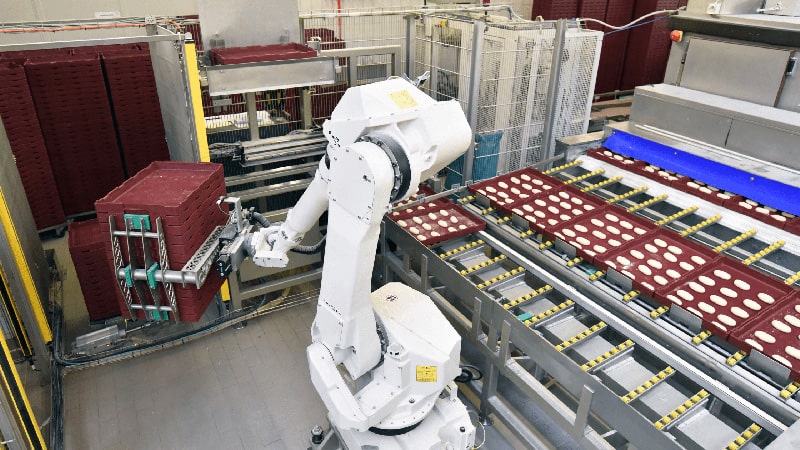Robotics in the Food Industry – How Robots are Used for Food Packaging and Processing

The food industry is not what it used to be fifty years ago. While the food items we consume are more or less the same, food processing and food packaging have been changing thanks to robotics and automation in the food industry.
The emergence of information technology has led to changes in the food and beverage industry in every step, be it agriculture, food manufacturing, or robotics in food packaging. In this article, we examine how food robots are changing the industry. Keep reading to find out more.
What is Food Robotics?
Food robotics is the application of robots and automation in the food industry by manufacturers. From packing to meat processing, companies have started to deploy robotics in almost every process, replacing manual workers.
In fact, the demand for technologies like robotics automation is so much that the market is expected to be worth $4 billion in 2026. The market and evolving technologies are driven by the automation employed in the large-scale production of food and its packaging.
How has automation changed the food industry?

When we think about the impact of the robotics food industry, the consequences of change are significant.
Let’s start with efficiency and the fact that what used to be done in hours by human hands is now done by food processing and packaging robots in seconds. By processing and packaging more food items in less time, food robots have scaled up production with the growing demand by customers.
By reducing the amount of labor required in production and packaging, food robotics has also helped improve food safety and keep the cost of food down, even when it requires lengthy and ever-changing processing, picking, and sorting methods.
What are the benefits of using automation and robotics in the food industry?
The advantages of automation and robots in food manufacturing, processing, and packaging go far beyond what you might think. Some of these benefits include:
1. Quality Control
Quality control is one of the most visible benefits of robotics in food. For example, imagine eating sliced bread packaged a few decades ago, processed by human hands. The slices were unequal, the weight of slices varied greatly, and there was always the risk of contamination due to human intervention on the production line.
Now add food manufacturing robots to the equation doing repetitive tasks, such as production, sorting, and packaging, even a simple automated cutting machine. The result is evenly sliced bread with no loss of quality and no risk of contamination. And the weight of each slice is consistent.
While this is a simple example, it applies to all food processing areas. Rapid sorting of items, such as fruits and grains, has revolutionized many food production facilities.
2. Improved Efficiency
The application of automation and robotics in food production has led to exponentially faster production. Collaborative robots now fill hundreds of packages and bottles and do other complex tasks more efficiently than humans did. For example, in warehouses, palletizing robots have led to companies boosting production significantly in a short period. Pick and place robots used for food picking applications are another game changer for every company using them!
3. Reduced Costs

Automation and food production robots require an initial investment to set up when starting, but the ongoing and recurring expenses for robot applications are minimal. Much less than for employees. Low recurring costs and high-speed production mean a robot can prepare the same food items at a significantly lower cost.
4. Workforce Safety
The application of automation and robotic applications in dangerous areas of food manufacturing has led to increased worker safety and food safety. For instance, an automated meat processing robot has limited the risk of a person harming their hands and fingers with a knife.
The safety aspect of using a robot for such applications is relevant to food handling in factories and agriculture. Harmful chemicals like pesticides can be sprayed by automated robot systems instead of manual labor, reducing the risk of chemical contamination.
5. Brand Reputation
Consistency across products is vital in brand reputation. A good brand wants all similar food products in its product line to have uniform characteristics.
Such uniformity is possible with automated food manufacturing robots. Food robots help brands maintain their reputation by rejecting defective food products during production.
How are robotics used in the food industry?

Robotics have many applications in the food industry. Here are some of their use cases:
Agriculture and Food Manufacturing
- Agriculture utilizes robotics and automation in diverse ways. Key areas include automated robot harvesting, produce fertilizing, and irrigation systems.
- Such improvements reduce the cost of labor and resources by maximizing an even spread of fertilizers, water, fuel, etc.
- The use of robot automation has also allowed for faster agricultural processes. Automated robots can process acres of land in a significantly shorter time than human labor working in a similar area.
- In large-scale poultry and animal breeding, an automatic system can ensure the distribution of animal feed and the collection of produce like eggs.
Food Packaging:
- Food packaging is one of the most prominent areas where manufacturers use robotics to perform tasks, whether handling primary packaging or meats or secondary packages.
- Examples of automated machines include slicing machines, case packers, and pick and place robots for individual foods.
- Automated food packaging systems, such as those provided by PWR, are used to automate food handling in every stage of primary processing and secondary food processing.
Food Delivery
- Technology advances in robotics have also changed how retailers handle food delivery to end-users. Many grocery stores nowadays focus on using self-checkout counters where customers can process the billing of their cart themselves.
- Food delivery robots are gaining popularity nowadays. These robots handle transporting meals from one point to another, thereby offering safe way meal transportation without any need for human handling.
Safety
- Autonomous floor care robots help maintain the hygiene standards of retailers, grocery stores, and food processing facilities. They also help in redistributing labor to more productive goals.
- Handling high-risk cutting tasks can be done by a robotic arm, ensuring the safety of the workforce. It maintains food safety and reduces foodborne illnesses.
Cooking and Food Preparation
- Robotic solutions and new technology help precise measurement and pre-selection of ingredients in the cooking process, ensuring consistent cooking every time.
- Restaurants and packagers employ automated solutions for cutting meat and vegetables by lasers and other equipment to do basic tasks faster.
Food Processing
- Primary cutting, sorting, and packing in meat processing are primarily done by robots nowadays, as humans are not optimal for these jobs.
- A benefit of robots in food processing is that robots can work in sub-zero temperature conditions, such as large cold freezers. Humans are not comfortable in these conditions.
- Robots are widely used in the dairy industry, from the primary task of collecting milk to secondary tasks such as stirring curd and slicing cheese.
Challenges when using robots in the food industry?

While robotics has made the food industry more efficient and safer, there are challenges to using robots. Some of these challenges include:
- Loss of human labor: The aim of robotics is to reduce costs in primary processing through higher productivity and reducing human labor. The lack of human labor required results in fewer jobs for people. For instance, if robots replace people doing meat processing tasks, many workers will be without work.
- Bottlenecks: If robotics are deployed in secondary food processing alongside human labor in some other steps, there will be bottlenecks in some areas. Human labor cannot match the speed of robots.
- Lack of customization: Robots are a good choice for consistent operation. However, some tasks have customized requirements that vary from piece to piece. Robots are generally not a good fit for these requirements as workers are needed for such work.
Costs
System costs are a factor when considering whether to utilize food robotics in the industry. These costs vary greatly based on the area in which robots are deployed.
The initial cost for autonomous robots can be high. But the ongoing costs are negligible when compared with human labor. There are no salaries or health benefits required.
Buying Considerations
There are some buying considerations you should keep in mind before going ahead with food robotics:
- Scale of operation: Food robotic systems are helpful and economically feasible in medium to large scale food industries. However, if you are wondering about buying a cutting machine for a restaurant or a cafe, you should calculate if your increased profit margins will justify the cost.
- Required method of implementation: Food robotic technology of a particular type can come in varying shapes and sizes. Consider which machine you want to buy based on the expected results and current availability of resources. For instance, there are both vertical and horizontal machine solutions for a system making milk pouches. What you implement should be based on the size allocation of your facility.
Will robots take over the food industry?

Across the world, robotics will take over the food industry in the future. In fact, in a lot of industries, the science of robotics has already taken over and has become the driving force.
External factors such as lack of human contact have given robotics an advantage for the future, especially in recent years, due to the pandemic the world has experienced.
Endnotes
It is high time that everyone in the food industry begins harnessing the power of food robotics. It is no longer a questionable science; the results have proven their effectiveness regardless of the system in which robotics are deployed in the food sector.
Are you considering buying autonomous food robotics? The best place to start is with the industry-leading machinery and solutions provided by PWR, used by most food packagers and processors out there.
Frequently Asked Questions (FAQs)
Here are the answers to some common questions regarding food robotics:
1. Why automation is necessary for the food industry?
The demand for food is growing exponentially with the growing population. Food robotic automation speeds up production to meet the ever-growing demand. That is why food grade robots are essential for the future.
2. Can I implement robots along the entire food production line?
Yes, there is an automated robotics solution for every step in the food processing system. Maybe you need pick-and-place robotic technology to replace a forklift or robot cutter for vegetables and meat. With a robot, foods can be processed and handled more efficiently. You will find a robot for every requirement.









